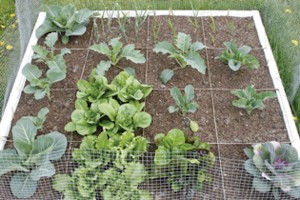Square-foot gardening utilizes small areas
Chronicle Media — March 30, 2016
Square foot gardening utilizes a raised bed and grows vegetables in a compact 16-foot area. (Photo courtesy University of Illinois)
Have you ever attempted to grow vegetables with grand visions of fresh produce that would litter your kitchen counter? Instead your broccoli went to the worms, your tomatoes were riddled with disease, or your garden was overrun with weeds.
Then square-foot gardening is the answer for you.
“Even though there is snow on the ground, it is time to start putting together a realistic plan,” states University of Illinois Extension Horticulture Educator Kelly Allsup.
Square-foot gardening utilizes a raised bed and grows vegetables in a compact 16-foot area. Each square foot is dedicated to one type of vegetable and the entire garden can produce enough vegetables for one to two people.
This garden can be built out of four foot, two by six inch untreated boards as most vegetables roots do not exceed six inches. The base can be weed barrier, cardboard or newspaper. The location is anywhere in the sun.
After adding the soil, add a grid with 16 squares out of string or wooden stakes. Reap all these benefits of square-foot gardening:
Square foot gardening is the perfect kitchen garden set up.
Because each square foot is dedicated to a particular vegetable it is fairly easy to manage. Once the vegetable has been harvested, it is ready for another crop. It actually is a space saver compared to traditional row set-ups.
The garden can be set up in the sunniest location and close to a water source. The bed can be on the driveway, in the front yard, or close to your outdoor seating area. Even without a yard, a square foot garden can be assembled.
Soil with a mix of compost and peat moss produces the most ideal root growth.
The soil stays nice and loose because it is not being compacted by walking on it.
Easy to grow vegetables like spinach, lettuce, herbs, onions, eggplant, carrots, beets, radish, turnips, peas and potatoes can be planted.
Plant for your vegetable’s mature size. A foot section that can hold 16 carrot plants placed three inches apart has only room for nine spinach plants placed four inches apart and only one eggplant. Taller plants should be on the south side. Use compact plants for better success.
Build in a trellis system at the time of planting so the plant does not get away from you. Face trellis systems north to south.
Put up a chicken-wire fence to keep the bunnies from nibbling on your vegetables.
Do not forget that squares can be filled with flowers that attract beneficial insects like marigolds, cosmos, dwarf sunflowers or zinnias.
For more information, contact Kelly Allsup, Extension unit educator, Horticulture-Livingston, McLean and Woodford Unit at (309) 663-8306 or email Kelly at kallsup@illinois.edu.






